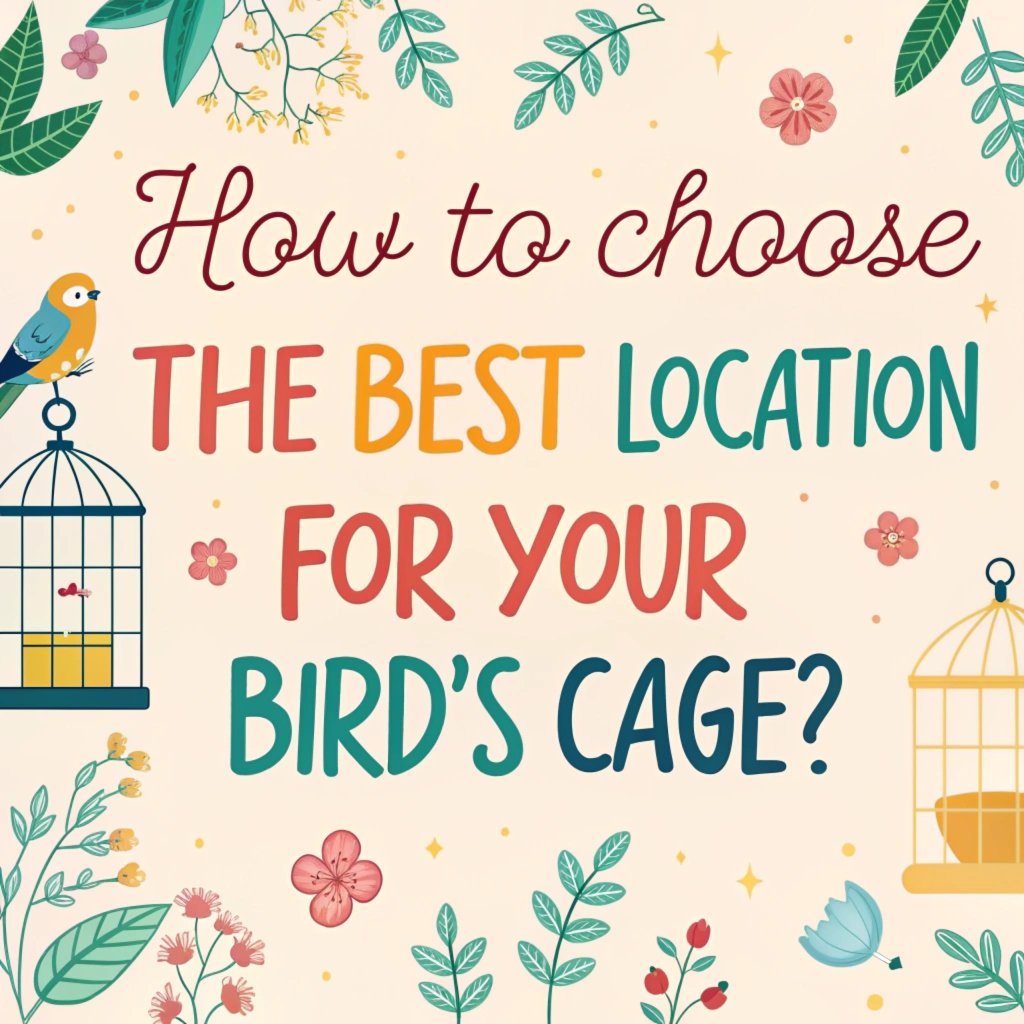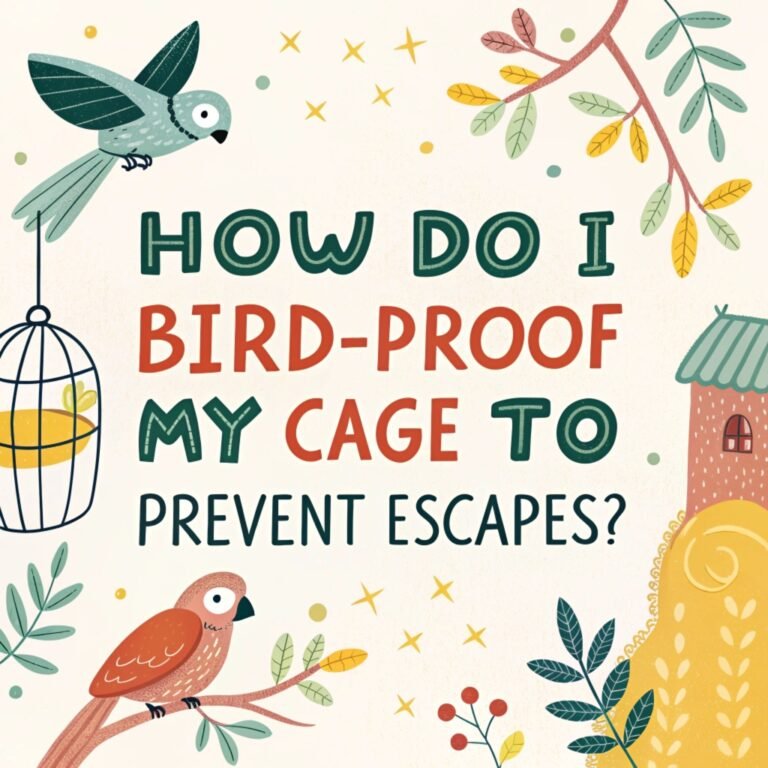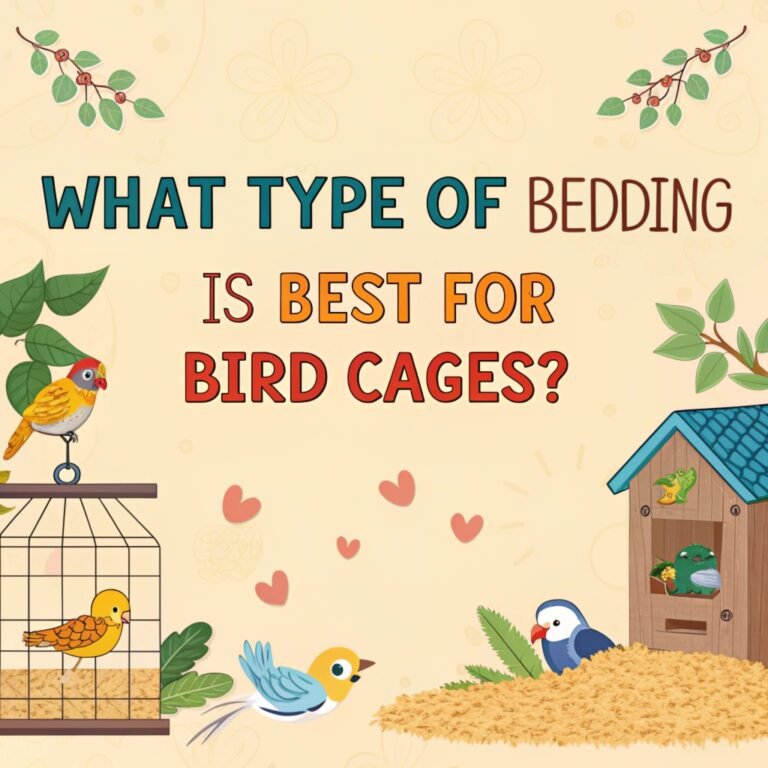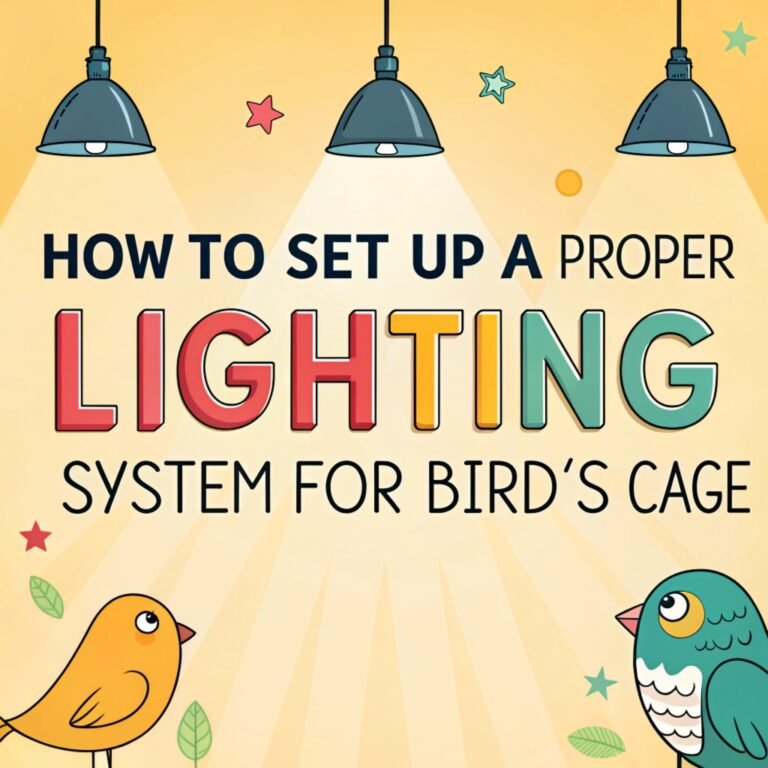How to Choose the Best Location for Your Bird’s Cage? – Ensuring Comfort, Safety, and Happiness for Your Feathered Friend
When bringing a new feathered companion into your home, one of the most crucial decisions you’ll make is determining the ideal location for their cage.
The placement of your bird’s home can significantly impact their health, happiness, and overall well-being.
This comprehensive guide will walk you through the essential factors to consider when selecting the perfect spot for your avian friend’s abode.

Key Takeaways:
- Quiet Environment: Select a calm area away from loud noises and high-traffic zones to reduce stress.
- Natural Light Access: Ensure exposure to natural light while avoiding direct sunlight.
- Good Air Circulation: Choose a well-ventilated space, but avoid drafts and sudden temperature changes.
- Family Interaction: Place the cage in a room where the bird can interact with family members.
- Safety Considerations: Keep the cage away from potential hazards like kitchens or toxic plants.
- Eye-Level Placement: Position the cage between chest and eye level for optimal interaction.
- Wall Proximity: Place at least one side of the cage against a wall for a sense of security.
- Temperature Control: Avoid locations near heat sources or air conditioning units.
- Visual Stimulation: Provide a partial view of windows for entertainment without overwhelming the bird.
- Sleep Quality: Ensure the location allows for 10-12 hours of undisturbed sleep in a dark, quiet environment.
Selecting a Quiet and Peaceful Environment
Creating a tranquil atmosphere for your bird is paramount to their well-being. Birds are highly sensitive creatures that can easily become stressed by excessive noise and commotion.
When choosing the best location for your bird’s cage, prioritize a quiet area of your home where your feathered friend can feel at ease.
Avoid placing the cage in high-traffic zones or near sources of loud, sudden noises such as televisions or stereos.
A peaceful environment will contribute to your bird’s overall health, promoting better sleep patterns and reducing anxiety.
Consider rooms like a spare bedroom or a quiet corner of your living room where your bird can observe family activities without being overwhelmed by constant noise and movement.
Ensuring Access to Natural Light

Natural light plays a crucial role in maintaining your bird’s physical and emotional health. When selecting the ideal location for your bird’s cage, aim for a spot that receives ample natural light throughout the day.
However, it’s essential to strike a balance – while birds benefit from exposure to natural light, direct sunlight can be harmful and cause overheating.
Position the cage in an area where it receives indirect sunlight or filtered light through curtains or blinds.
This arrangement will provide your bird with the necessary vitamin D and help regulate their natural circadian rhythms.
A room with large windows or a sunroom can be an excellent choice, as long as you can control the amount of direct sunlight reaching the cage.
Optimizing Air Circulation and Ventilation
Proper air circulation is vital for your bird’s respiratory health and overall comfort. When choosing the best location for your bird’s cage, look for a well-ventilated area that allows for a steady flow of fresh air.
However, be cautious of placing the cage in areas with strong drafts or near air vents, as these can cause rapid temperature fluctuations that may be detrimental to your bird’s health.
A room with windows that can be opened for periodic fresh air is ideal, but ensure that the cage is not directly in the path of incoming breezes.
Good ventilation helps prevent the buildup of dust and dander, which can irritate your bird’s sensitive respiratory system.
Consider using an air purifier in the room to further improve air quality and create a healthier environment for your feathered friend.
Promoting Family Interaction and Socialization

Birds are highly social creatures that thrive on interaction with their human family members. When selecting the best location for your bird’s cage, choose an area where your feathered friend can be an active part of family life.
A living room or family room is often an excellent choice, as these spaces typically see frequent activity and allow your bird to observe and participate in daily routines.
However, be mindful not to place the cage in an area that’s too hectic or overwhelming.
The ideal spot should allow for regular interaction while providing your bird with the option to retreat to a quieter corner of their cage when they need some downtime.
This balance will help your bird feel included in family activities while respecting their need for occasional solitude.
Avoiding Potential Hazards and Dangerous Areas
Safety should be a top priority when choosing the location for your bird’s cage. Avoid placing the cage in areas that could pose potential risks to your feathered friend’s health and well-being.
The kitchen is generally not a suitable location due to the presence of fumes from cooking, cleaning products, and the risk of accidental burns or scalds.
Similarly, avoid rooms with toxic plants or areas where household chemicals are stored or used.
Be cautious of placing the cage near windows or doors that are frequently opened, as this could lead to drafts or potential escape attempts.
Additionally, keep the cage away from other pets that might stress or harm your bird. By carefully considering potential hazards, you can create a safe and secure environment for your avian companion.
Positioning the Cage at Eye Level
The height at which you place your bird’s cage can significantly impact their comfort and sense of security. Ideally, position the cage so that the middle or upper portion is at your eye level or slightly below.
This placement allows for easy interaction with your bird and helps them feel more at ease, as they prefer to be at or above eye level with their human companions.
Avoid placing the cage too low, as this can make your bird feel vulnerable and anxious.
Conversely, a cage placed too high can make it difficult for you to provide proper care and may lead to your bird feeling isolated.
By keeping the cage at an appropriate height, you create an environment that promotes positive interactions and helps your bird feel safe and valued.
Providing a Sense of Security with Wall Proximity
Birds often feel more secure when they have a solid barrier on at least one side of their cage. When choosing the best location, consider placing the cage with one or two sides against a wall.
This arrangement provides your bird with a sense of protection and reduces their feelings of vulnerability.
A corner placement can be particularly effective, as it offers two solid sides and allows your bird to have a clear view of the room.
However, ensure that the cage is not pushed too tightly against the wall, as this can limit air circulation and make cleaning more difficult.
The ideal setup allows for some space between the cage and the wall while still providing that crucial sense of security that helps your bird feel safe and comfortable in their environment.
Managing Temperature and Avoiding Extreme Conditions
Birds are sensitive to temperature fluctuations, and maintaining a stable, comfortable environment is crucial for their health. When selecting the best location for your bird’s cage, avoid areas prone to extreme temperature changes or drafts.
Keep the cage away from air conditioning vents, radiators, and heating units, as these can cause rapid temperature shifts that may stress your bird.
Similarly, avoid placing the cage in direct sunlight or near windows that receive strong sunlight for extended periods, as this can lead to overheating.
The ideal location should maintain a consistent temperature between 65-75°F (18-24°C) for most bird species.
Consider using a thermometer near the cage to monitor the temperature and ensure it remains within a comfortable range for your feathered friend.
Balancing Visual Stimulation and Overstimulation
Providing your bird with visual stimulation is important for their mental well-being, but it’s equally crucial to avoid overstimulation.
When choosing the best location for your bird’s cage, aim for a spot that offers a partial view of a window or outdoor area.
This arrangement allows your bird to observe nature, weather changes, and outdoor activities, which can be highly entertaining and enriching.
However, be cautious not to place the cage directly in front of a large window or in an area with constant, rapid movement, as this can be overwhelming and stressful for your bird.
The ideal setup provides a balance of interesting views and calm spaces, allowing your bird to engage with their surroundings while also having the option to retreat to a more secluded area of their cage when they need rest or quiet time.
Ensuring Quality Sleep and Nighttime Comfort
Quality sleep is essential for your bird’s health and well-being. When selecting the best location for your bird’s cage, consider how the area will accommodate your feathered friend’s need for 10-12 hours of undisturbed sleep each night.
Choose a spot where you can easily cover the cage or dim the lights to create a dark, quiet environment for sleeping.
Avoid placing the cage in rooms with late-night activity or areas prone to sudden noises that might startle your bird during sleep.
If possible, consider having a separate sleeping cage in a quieter room for nighttime use.
This arrangement allows you to maintain the main cage in a more social area during the day while providing a peaceful sleeping environment at night.
Consistent, quality sleep will contribute to your bird’s overall health, mood, and behavior.
Accommodating Multiple Birds and Cage Sizes
If you have multiple birds or are considering adding more feathered friends to your family, it’s important to choose a location that can accommodate multiple cages or a larger aviary setup.
When selecting the best spot, consider the long-term space requirements for your birds.
Ensure that the chosen area has enough room for cages to be placed side by side or stacked safely, allowing each bird to have its own territory while still being able to interact with its companions.
Additionally, factor in the need for play areas outside the cages and space for perches or play stands.
The ideal location should be flexible enough to adapt to your growing avian family, providing ample room for exercise, socialization, and enrichment activities.
Remember that different bird species may have varying space needs, so research the specific requirements for your particular birds when planning your cage setup.
Creating a Bird-Safe Room Environment
Beyond the immediate cage area, it’s crucial to ensure that the entire room where you place your bird’s cage is safe and bird-friendly.
When choosing the best location, consider the overall environment of the room. Remove or secure any potential hazards such as loose wires, toxic plants, or small objects that your bird might accidentally ingest if they escape the cage.
Ensure that windows and mirrors are covered or have decals to prevent your bird from flying into them.
If the room has ceiling fans, be cautious about their use when your bird is out of the cage.
Choose bird-safe cleaning products for maintaining the room and avoid using air fresheners or scented candles that could irritate your bird’s sensitive respiratory system.
By creating a comprehensive bird-safe environment, you provide your feathered friend with a secure space to explore and interact with their surroundings when they’re outside their cage.
Facilitating Easy Cleaning and Maintenance
The location you choose for your bird’s cage should also consider the practicality of cleaning and maintenance.
Select an area that allows easy access to all sides of the cage for regular cleaning and disinfection.
Avoid placing the cage in tight corners or against furniture that might make it difficult to perform thorough cleanings.
Consider the flooring in the chosen location – a hard surface like tile or linoleum is easier to clean than carpet if seed husks or droppings fall outside the cage.
Ensure there’s enough space around the cage to comfortably change food and water dishes, replace toys, and perform other routine care tasks.
A location near a water source can be beneficial for refilling water dishes and cleaning accessories.
By choosing a spot that facilitates easy maintenance, you’ll be more likely to keep up with regular cleaning schedules, which is essential for your bird’s health and hygiene.
By considering factors such as light, temperature, air quality, and social interaction, you can create an ideal environment that allows your avian companion to thrive. Remember, a happy bird makes for a harmonious home.
Adapting the Location for Different Bird Species
Different bird species may have varying needs when it comes to cage placement. When choosing the best location, consider the specific requirements of your bird’s species.
For example, some tropical birds may prefer warmer, more humid environments, while others might thrive in cooler, drier conditions.
Nocturnal birds like some owl species will need a quieter, darker location during the day. Social birds like parrots might benefit from being in busier areas of the home, while more timid species might prefer a calmer setting.
Research your bird’s natural habitat and behaviors to inform your decision.
Additionally, consider the noise level of your bird species – louder birds like macaws might need to be placed in areas where their vocalizations won’t disturb household members or neighbors.
By tailoring the cage location to your specific bird’s needs, you can create an environment that closely mimics their natural habitat and supports their overall well-being.
Birds bring joy and companionship to many households. Choosing the right location for your feathered friend’s cage is crucial for their well-being and happiness.
A thoughtfully placed cage can make a significant difference in your bird’s life, promoting better health, reducing stress, and fostering a stronger bond between you and your pet.
FAQs
Is it okay to put my bird’s cage in my bedroom?
While it’s possible to keep your bird’s cage in your bedroom, it’s generally not the ideal location. Bedrooms often lack the social interaction and stimulation that birds need during the day. Additionally, birds require 10-12 hours of uninterrupted sleep, which might be difficult to provide if you have different sleep schedules or nighttime activities. If you do choose to keep your bird in your bedroom, ensure that you can provide adequate interaction during waking hours and a quiet, dark environment for sleep.
How far should a bird cage be from a window?
A bird cage should be placed near a window to provide natural light and visual stimulation, but not directly in front of it. Ideally, position the cage about 3-4 feet away from the window. This distance allows your bird to enjoy the view and natural light without being exposed to drafts or extreme temperature fluctuations. Ensure that the cage isn’t in direct sunlight for extended periods, as this can cause overheating.
Can I keep my bird’s cage on a patio or balcony?
While outdoor exposure can be beneficial for birds, keeping their cage permanently on a patio or balcony is not recommended. Outdoor environments pose risks such as extreme weather conditions, predators, and exposure to pollutants or pesticides. However, you can create a safe outdoor area for supervised time outside the cage. If you want to provide fresh air, consider opening windows in the room where the cage is located, ensuring the bird is protected from drafts and potential escape.

Hello, I’m Amelia White, the founder of birdsfanatic.com. As a lifelong bird enthusiast and spiritual seeker, I’ve always been fascinated by the mystical connections between birds and the human experience. On this site, I share my knowledge and insights into the symbolic meanings and spiritual significance of various bird species, exploring their roles in mythology, folklore, and cultural traditions. Join me on this journey into the world of birds, where we’ll discover the hidden wisdom and guidance that these magnificent creatures have to offer.







